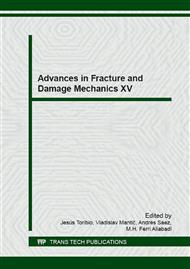p.107
p.111
p.115
p.119
p.123
p.127
p.131
p.135
p.139
Determination of Initial Stages of Fatigue on the Basis of Fatigue Tensile and Fatigue Bend Testing
Abstract:
Fatigue crack initiation usually starts from defects or inclusion (s) in the material in the zone of stress concentration. The stress concentration zone can be at the surface of the specimen or inside the material. The fatigue crack starts to propagate, depending on stress amplitude, if the range of the stress intensity factor is higher than the fatigue threshold. The aim of this paper is to present the procedure for determining the fatigue crack initial stage by using the Wöhler S-N curve and the fatigue crack propagation parameters obtained by experiment for the loading range R=-1. Determination of the fatigue initial stage has been determined by the analysis of tensile smooth specimens and notched bending specimens. Results show that linear elastic fracture mechanics is applicable in order to establish a model for fatigue crack propagation.
Info:
Periodical:
Pages:
123-126
Citation:
Online since:
September 2016
Authors:
Keywords:
Price:
Сopyright:
© 2016 Trans Tech Publications Ltd. All Rights Reserved
Share:
Citation:


